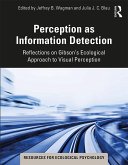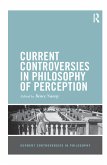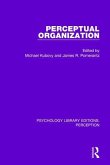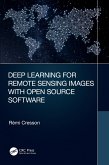- Broschiertes Buch
- Merkliste
- Auf die Merkliste
- Bewerten Bewerten
- Teilen
- Produkt teilen
- Produkterinnerung
- Produkterinnerung
It was in the 20th century and after the establishment of psychology as a scientific discipline that the study of perception flourished. This important volume gathers together a selection of articles and essays which represent some of the most interesting discoveries and theories.
Andere Kunden interessierten sich auch für
![Perception as Information Detection Perception as Information Detection]() Perception as Information Detection49,99 €
Perception as Information Detection49,99 €![Current Controversies in Philosophy of Perception Current Controversies in Philosophy of Perception]() Bence NanayCurrent Controversies in Philosophy of Perception42,99 €
Bence NanayCurrent Controversies in Philosophy of Perception42,99 €![Figural Synthesis Figural Synthesis]() Figural Synthesis175,99 €
Figural Synthesis175,99 €![Consent, Stealthing and Desire-Based Contracting in the Criminal Law Consent, Stealthing and Desire-Based Contracting in the Criminal Law]() Brianna Chesser (Dr. Brianna Chesser is a Senior Lecturer in CriminConsent, Stealthing and Desire-Based Contracting in the Criminal Law31,99 €
Brianna Chesser (Dr. Brianna Chesser is a Senior Lecturer in CriminConsent, Stealthing and Desire-Based Contracting in the Criminal Law31,99 €![Perceptual Organization Perceptual Organization]() Perceptual Organization59,99 €
Perceptual Organization59,99 €![Self-Insight Self-Insight]() David DunningSelf-Insight75,99 €
David DunningSelf-Insight75,99 €![Deep Learning for Remote Sensing Images with Open Source Software Deep Learning for Remote Sensing Images with Open Source Software]() Remi Cresson (IRSTEA / INRAE / UMR TETIS)Deep Learning for Remote Sensing Images with Open Source Software60,99 €
Remi Cresson (IRSTEA / INRAE / UMR TETIS)Deep Learning for Remote Sensing Images with Open Source Software60,99 €-
-
-
It was in the 20th century and after the establishment of psychology as a scientific discipline that the study of perception flourished. This important volume gathers together a selection of articles and essays which represent some of the most interesting discoveries and theories.
Hinweis: Dieser Artikel kann nur an eine deutsche Lieferadresse ausgeliefert werden.
Hinweis: Dieser Artikel kann nur an eine deutsche Lieferadresse ausgeliefert werden.
Produktdetails
- Produktdetails
- Verlag: Taylor & Francis Ltd
- Seitenzahl: 516
- Erscheinungstermin: 28. Februar 2022
- Englisch
- Abmessung: 246mm x 174mm x 28mm
- Gewicht: 854g
- ISBN-13: 9781138355972
- ISBN-10: 1138355976
- Artikelnr.: 63658533
- Herstellerkennzeichnung
- Libri GmbH
- Europaallee 1
- 36244 Bad Hersfeld
- gpsr@libri.de
- Verlag: Taylor & Francis Ltd
- Seitenzahl: 516
- Erscheinungstermin: 28. Februar 2022
- Englisch
- Abmessung: 246mm x 174mm x 28mm
- Gewicht: 854g
- ISBN-13: 9781138355972
- ISBN-10: 1138355976
- Artikelnr.: 63658533
- Herstellerkennzeichnung
- Libri GmbH
- Europaallee 1
- 36244 Bad Hersfeld
- gpsr@libri.de
Marco Bertamini University of Liverpool, Michael Kubovy University of Virginia, USA.
Contents: Series Preface; Introduction. Part I Attention: A feature-integration theory of attention
Anne M Treisman and Garry Gelade; Attention and the detection of signals
Michael I. Posner
Charles R.R. Snyder and Brian J. Davidson; Abrupt visual onsets and selective attention: voluntary versus automatic allocation
Steven Yantis and John Jonides; What attributes guide the deployment of visual attention and how do they do it
Jeremy M. Wolfe and Todd S. Horowitz. Part II Brain Systems: Implications of sustained and transient channels for theories of visual pattern masking
saccadic suppression
and information processing
Bruno G. Breitmeyer and Leo Ganz; Neuronal correlates of subjective visual-perception
Nikos K. Logothetis and Jeffrey D. Schall; Separate visual pathways for perception and action
Melvyn A Goodale and A. David Milner. Part III Object Interpolation and Completion: Subjective contours
Gaetano Kanizsa; Perceiving objects across gaps in time and space
Philip J. Kellman and Thomas F. Shipley; Infants' physical world
Ren Baillargeon. Part IV Object Recognition and Classification: Objects
parts
and categories
Barbara Tversky and Kathleen Hemenway; Parts of recognition
D.D. Hoffman and W.A. Richards; Recognition-by-components: a theory of human image understanding
Irving Biederman. Part V Different Types of Objects: What is 'special' about face perception?
Martha J. Farah
Kevin D. Wilson
Maxwell Drain and James N.Tanaka; The reviewing of object files: object-specific integration of information
Daniel Kahneman
Anne Treisman and Brian J. Gibbs; Auditory and visual objects
Michael Kubovy and David Van Valkenburg; The shape of holes
Marco Bertamini and Camilla J. Croucher. Part VI Information Processing and Models: The discovery of processing stages: extensions of Donder's method
Saul Sternberg Ecological constraints on internal representation: resonant kinematics of perceiving
imagining
thinking
and dreaming
Roger N. Shepard; Neu
Anne M Treisman and Garry Gelade; Attention and the detection of signals
Michael I. Posner
Charles R.R. Snyder and Brian J. Davidson; Abrupt visual onsets and selective attention: voluntary versus automatic allocation
Steven Yantis and John Jonides; What attributes guide the deployment of visual attention and how do they do it
Jeremy M. Wolfe and Todd S. Horowitz. Part II Brain Systems: Implications of sustained and transient channels for theories of visual pattern masking
saccadic suppression
and information processing
Bruno G. Breitmeyer and Leo Ganz; Neuronal correlates of subjective visual-perception
Nikos K. Logothetis and Jeffrey D. Schall; Separate visual pathways for perception and action
Melvyn A Goodale and A. David Milner. Part III Object Interpolation and Completion: Subjective contours
Gaetano Kanizsa; Perceiving objects across gaps in time and space
Philip J. Kellman and Thomas F. Shipley; Infants' physical world
Ren Baillargeon. Part IV Object Recognition and Classification: Objects
parts
and categories
Barbara Tversky and Kathleen Hemenway; Parts of recognition
D.D. Hoffman and W.A. Richards; Recognition-by-components: a theory of human image understanding
Irving Biederman. Part V Different Types of Objects: What is 'special' about face perception?
Martha J. Farah
Kevin D. Wilson
Maxwell Drain and James N.Tanaka; The reviewing of object files: object-specific integration of information
Daniel Kahneman
Anne Treisman and Brian J. Gibbs; Auditory and visual objects
Michael Kubovy and David Van Valkenburg; The shape of holes
Marco Bertamini and Camilla J. Croucher. Part VI Information Processing and Models: The discovery of processing stages: extensions of Donder's method
Saul Sternberg Ecological constraints on internal representation: resonant kinematics of perceiving
imagining
thinking
and dreaming
Roger N. Shepard; Neu
Contents: Series Preface; Introduction. Part I Attention: A feature-integration theory of attention
Anne M Treisman and Garry Gelade; Attention and the detection of signals
Michael I. Posner
Charles R.R. Snyder and Brian J. Davidson; Abrupt visual onsets and selective attention: voluntary versus automatic allocation
Steven Yantis and John Jonides; What attributes guide the deployment of visual attention and how do they do it
Jeremy M. Wolfe and Todd S. Horowitz. Part II Brain Systems: Implications of sustained and transient channels for theories of visual pattern masking
saccadic suppression
and information processing
Bruno G. Breitmeyer and Leo Ganz; Neuronal correlates of subjective visual-perception
Nikos K. Logothetis and Jeffrey D. Schall; Separate visual pathways for perception and action
Melvyn A Goodale and A. David Milner. Part III Object Interpolation and Completion: Subjective contours
Gaetano Kanizsa; Perceiving objects across gaps in time and space
Philip J. Kellman and Thomas F. Shipley; Infants' physical world
Ren Baillargeon. Part IV Object Recognition and Classification: Objects
parts
and categories
Barbara Tversky and Kathleen Hemenway; Parts of recognition
D.D. Hoffman and W.A. Richards; Recognition-by-components: a theory of human image understanding
Irving Biederman. Part V Different Types of Objects: What is 'special' about face perception?
Martha J. Farah
Kevin D. Wilson
Maxwell Drain and James N.Tanaka; The reviewing of object files: object-specific integration of information
Daniel Kahneman
Anne Treisman and Brian J. Gibbs; Auditory and visual objects
Michael Kubovy and David Van Valkenburg; The shape of holes
Marco Bertamini and Camilla J. Croucher. Part VI Information Processing and Models: The discovery of processing stages: extensions of Donder's method
Saul Sternberg Ecological constraints on internal representation: resonant kinematics of perceiving
imagining
thinking
and dreaming
Roger N. Shepard; Neu
Anne M Treisman and Garry Gelade; Attention and the detection of signals
Michael I. Posner
Charles R.R. Snyder and Brian J. Davidson; Abrupt visual onsets and selective attention: voluntary versus automatic allocation
Steven Yantis and John Jonides; What attributes guide the deployment of visual attention and how do they do it
Jeremy M. Wolfe and Todd S. Horowitz. Part II Brain Systems: Implications of sustained and transient channels for theories of visual pattern masking
saccadic suppression
and information processing
Bruno G. Breitmeyer and Leo Ganz; Neuronal correlates of subjective visual-perception
Nikos K. Logothetis and Jeffrey D. Schall; Separate visual pathways for perception and action
Melvyn A Goodale and A. David Milner. Part III Object Interpolation and Completion: Subjective contours
Gaetano Kanizsa; Perceiving objects across gaps in time and space
Philip J. Kellman and Thomas F. Shipley; Infants' physical world
Ren Baillargeon. Part IV Object Recognition and Classification: Objects
parts
and categories
Barbara Tversky and Kathleen Hemenway; Parts of recognition
D.D. Hoffman and W.A. Richards; Recognition-by-components: a theory of human image understanding
Irving Biederman. Part V Different Types of Objects: What is 'special' about face perception?
Martha J. Farah
Kevin D. Wilson
Maxwell Drain and James N.Tanaka; The reviewing of object files: object-specific integration of information
Daniel Kahneman
Anne Treisman and Brian J. Gibbs; Auditory and visual objects
Michael Kubovy and David Van Valkenburg; The shape of holes
Marco Bertamini and Camilla J. Croucher. Part VI Information Processing and Models: The discovery of processing stages: extensions of Donder's method
Saul Sternberg Ecological constraints on internal representation: resonant kinematics of perceiving
imagining
thinking
and dreaming
Roger N. Shepard; Neu








